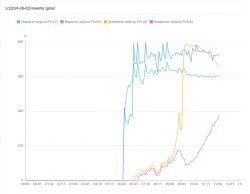webonek wrote:[letter:3d76cd34b0]33V x 9A = 297W --> 0.79% power according to STCThe voltage on the panels (I see this with the optimisers) seems(?) correct to me: about 32-33 V as the sun shines for 375 W and about 2 V less for 325 W. The maximum current is around 9 and 8 A respectively. So what conclusion...?
31V x 8A = 248W --> 0.76% power according to STCLike a bit by the small side, especially that string from the 325W panels. Unless you've just caught such lousy days. In a sunny summer the panels should give like 85...90% power according to STC.
webonek wrote:It's just like here - that is, around to 90% power according to STC.But that's how the 5 kW worked - the same Huawei model: with a 6.1 kWp installation, it gave quite a long peak of 5.5 kW.
webonek wrote:And this is already slightly suspicious.After rewiring the inverter itself to 8 kW, 6 kW production appeared.
webonek wrote:And maybe this is some problem with the optimisers?And now exactly the same string (because it has remained the same) on a different inverter doesn't even do 5 kW, but some 4.7 kW. And the power of the panels is more than 30% higher.
webonek wrote:Well, it looks like they know what they're talking about.To this, Huawei support itself claimed at the upgrade that, and I quote: "with a 10 kWp installation, an 8 kW inverter will have a peak of 8.8 kW".








